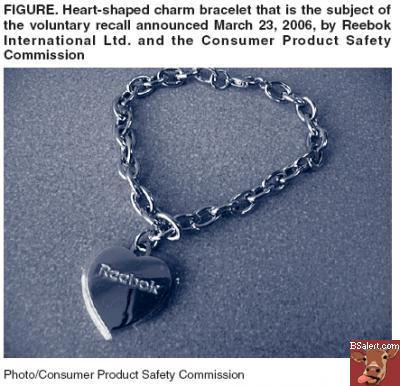|
|
Reebok Shoes Are Killer, Thanks To The Bush Administration
Posted by Pile
(14567 views) |
[Faulty Products] |
 In the wake of a massive Chinese toy recall, scrutiny is showing that the Bush administration has gone out of its way to weaken existing controls to insure the safety of products imported into the country. In the wake of a massive Chinese toy recall, scrutiny is showing that the Bush administration has gone out of its way to weaken existing controls to insure the safety of products imported into the country. | |
The Bush administration and China have both undermined efforts to tighten rules designed to ensure that lead paint isn't used in toys, bibs, jewelry and other children’s products. Both have fought efforts to better police imported toys from China. Now both are under increased scrutiny following last week’s massive toy recall by Mattel Inc., the world’s largest toymaker. The recalls of Chinese-made toys follow several other lead-paint-related scares since June that have affected products featuring Sesame Street characters, Thomas the Train and Dora the Explorer. Lead paint is toxic when ingested by children and can cause brain damage or death. It’s been mostly banned in the United States since the late 1970s, but is permitted in the coating of toys, providing it amounts to less than six parts per million. The Bush administration has hindered regulation on two fronts, consumer advocates say. It stalled efforts to press for greater inspections of imported children’s products, and it altered the focus of the Consumer Product Safety Commission (CPSC), moving it from aggressive protection of consumers to a more manufacturer-friendly approach. “The overall philosophy is regulations are bad and they are too large a cost for industry, and the market will take care of it,” said Rick Melberth, director of regulatory policy at OMBWatch, a government watchdog group formed in 1983. “That’s been the philosophy of the Bush administration.” Today, more than 80 percent of all U.S. toys are now made in China and few of them get inspected. “We’ve been complaining about this issue, warning it is going to happen, and it is disappointing that it has happened,” said Tom Neltner, a co-chairman of the Sierra Club’s national toxics committee. The recent toy recalls — along with the presence of lead in vinyl baby bibs and children’s jewelry — are prompting the Bush administration to take a deeper look at the safety of toys and other imported products. President Bush has asked the Department of Health and Human Services to report in September on ways to better ensure safe imports. He's also asked the Centers for Disease Control and Prevention to consider responses to lead paint threats to children. But as recently as last December, the Sierra Club sued the Bush administration after the Environmental Protection Agency rebuffed a petition to require health and safety studies for companies that use lead in children’s products. The EPA and Sierra Club settled out of court in April, with the administration agreeing to write a letter to the CPSC that expressed concern about insufficient quality control on products containing lead. The Sierra Club’s interest in lead paint in children's products grew out of the largest-ever CPSC-conducted recall. That action on July 8, 2004, targeted 150 million pieces of Chinese-made children's jewelry sold in vending machines across the United States. Since 2003, the commission has conducted about 40 recalls of children’s jewelry because of high levels of lead. In March 2006, a 4-year-old Minnesota boy died of lead poisoning after swallowing a metal charm that came with Reebok shoes. The charm was found to contain more than 90 percent lead. Under federal regulations, lead paint is permitted in the coating of toys sold in the U.S., so long as it amounts to less than six parts per million.. The Bush administration has managed to screw this up in a variety of ways: 1) resisting better inspections of imported children’s products; 2) changing the focus on the Consumer Product Safety Commission (CPSC) away from protecting consumers and towards business-friendly policies; and 3) canceling a Clinton-era drive for an outright ban on lead in all children’s products. Earlier this year, for example, the Bush administration decided to look the other way on lead in children’s lunchboxes. Here’s the deal: the CPSC had two ways of testing these vinyl lunchboxes used by children. One involves dissolving part of the vinyl to see how much lead is in the solution; the other involves swiping the surface of a bag and then determining how much lead has rubbed off. Using the first method, the CPSC found that 20% of the lunchboxes exceeded safe levels of lead. In one instance, a lunchbox had 16 times the federal standard. Naturally, the CPSC ignored these test results, using the swipe/rub-off tests exclusively. What’s more, as the AP explained, researchers changed their testing protocol: “After a handful of tests, they increased the number of times they swiped each bag, again and again on the same spot, resulting in lower average results.” The test results also show that many lunchboxes were tested only on the outside, which isn’t where the food goes. Alexa Engelman, a researcher at the Center for Environmental Health, said, “They knew this all along and they didn’t take action on it. It’s upsetting to me. Why are we, as a country, protecting the companies? We should be protecting the kids.” | |
Details | |
| Posted by Soundwave on 2007-08-22 09:50:49 |
| Lead should not be used in any kind of paint anymore. We have more then enough ways to create paint without using lead. Especially anything that could come in contact with food or mouths. |
| 1 Article displayed. |


 Bumper Sticker Store
Bumper Sticker Store



